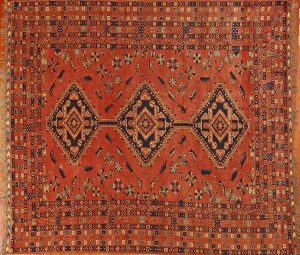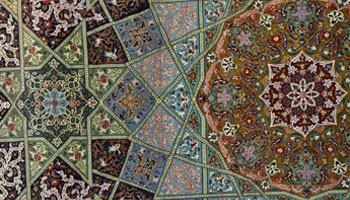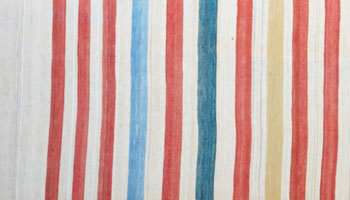Tracking an Afghan Rug’s Origin

At present, it is very hard to sort out which ‘Afghan’ rugs are actually made in Afghanistan, and which are made in Pakistan by Afghan refugees. At least a million Afghans, including hundreds of thousands of rug-weavers, fled Afghanistan during its war with the Soviet Union and subsequent civil war, settling especially in Pakistan and Iran.
The quintessential Afghan carpet of the past fifty years is a wool-on-wool product with a repeated octagonal figure (often inaccurately called elephant’s foot) on a red field. In the trade it is called simply Afghan or Dulatabad. Afghans are made by Turkmen weavers in northern Afghanistan. A hundred years ago the guls (as the octagonal figures are properly called) were large — often 16 inches wide in bigger rugs. Guls have become smaller over the years until today they most often are no more than several inches across. As the guls have shrunk, so has the range of colors in the rugs. Today most Afghans contain only two colors: a rather bright red and a blue so deep that it looks black. Still, Afghans have survived because they are basically so appealing.
Types of Afghan Rugs:
Afghan Rugs, or Daulatabad Rugs
The Daulatabad or Afghan is the traditional rug that most people in the Western world think of when they hear the words, “Afghan carpet.” This rug features octagon designs on a red background. These come from Northern Afghanistan, made by Turkmen and often with two colors: a vivid red and a very dark blue color. This is very popular with both Western and Afghan people and is quite easy to find.
Shindand or Adraskand Rugs
The Shindand or Adraskand rug is one of the most sought-after types of Afghan carpets. Named after the people who make them, these wool rugs are quite exotic and very similar to Oriental rugs. These feature animal and human forms, which is quite rare. Most Afghan rugs only feature geometric designs because Islamic traditions prohibit the portrayal of likenesses of animals and humans. Shindand rugs come from Herat in Northwestern Afghanistan.
Baluch Rugs
Baluch rugs are another popular type of Afghan rug, made by people from the Baluch area in the Western region of Afghanistan by Herat. One notable feature of these rugs is their small size. The Baluch people are nomads, so they make their rugs on portable looms and the prayer rugs measure around 2 feet by 4 feet. Most Baluch rugs feature vibrant patterns in red, blue, and brown colors and use a mix of goat hair and wool, though some modern rugs use cotton.
Kilims
One type of popular and inexpensive rug from Afghanistan is the kilim, a type of flat-woven rug. The Maimana kilim is actually widely available in the United States, particularly in New Mexico, as the colors and pattern are quite similar to the Southwest patterns and styles. The kilim has a distinct pattern, which features a small slit between different colors.
Mauri Rugs
Mauri rugs are perhaps the more luxurious type of Afghan rug. While Afghan carpets traditionally use coarse wool, Mauri rugs use asilk wra p. In addition, these rugs use a fine knotting, with a consistent and straight weave.
At Mansour’s, we offer some of the finest Afghan rugs and carpets as part of our collection. All of our Afghan rugs are unique and of the highest quality. We have a wide variety of choices including: runner rugs, large area rugs, small area rugs, antique rugs, and contemporary rugs. These are all natural rugs, made in the true tradition and by the hands of families who have made these carpets for generations.








